Photography for non-photographers
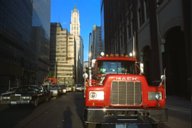

This page grew out of a talk I gave at a local photo club in 2001, so at the beginning it talks about something called 'film', but later discusses issues common to digital cameras.
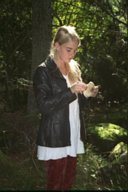 90% of the pictures I take could be taken with a $100 point-and-shoot
with a moderate zoom, and indeed many are, as I always have one with me because
they are small, light, and cheap to lose or damage. Johanna with the mushroom was taken
with a Konica super mini 35-70mm that I bought cheaply in 1994.
90% of the pictures I take could be taken with a $100 point-and-shoot
with a moderate zoom, and indeed many are, as I always have one with me because
they are small, light, and cheap to lose or damage. Johanna with the mushroom was taken
with a Konica super mini 35-70mm that I bought cheaply in 1994.
But as well as the obvious limitations for more technical pictures (very long zooms, close-ups), they tend to have less sharp lenses that particularly reveal themselves in poor light when a larger aperture (and hence more cheap glass) is used, and when you make bigger enlargements, like 20x30cm. Plus you don't normally have much control over aperture/speed combinations. With digital cameras you get more noise in the image with small cameras.
That's why people use 35mm SLRs - sharper images, a wider range of lenses, and technical features.
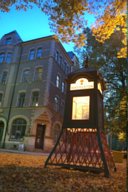 The phone-box picture would have been hard to take with a point-and-shoot - a wide-angle lens,
a small aperture despite the low light level, and precise composition.
In fact it was taken with a 20-year-old Olympus OM2n, basic but everything
you need in a tiny package, and you can still buy one second-hand for $150.
The winder on mine is getting a little dodgy though, and cheaper than repairing
it was to buy an OM4 to complement it. I also have 24mm f2.8, 28mm f2.8, 35-70mm f3.5,
70-150mm f4, 500mm f5.6 mirror, Sunpak 30DX TTL flash, close-up tubes,
and a few filters.
The phone-box picture would have been hard to take with a point-and-shoot - a wide-angle lens,
a small aperture despite the low light level, and precise composition.
In fact it was taken with a 20-year-old Olympus OM2n, basic but everything
you need in a tiny package, and you can still buy one second-hand for $150.
The winder on mine is getting a little dodgy though, and cheaper than repairing
it was to buy an OM4 to complement it. I also have 24mm f2.8, 28mm f2.8, 35-70mm f3.5,
70-150mm f4, 500mm f5.6 mirror, Sunpak 30DX TTL flash, close-up tubes,
and a few filters.
What do you get for paying $2000 for a new, hi-tech Nikon ? Ruggedness, clever metering, clever flash, and clever autofocus for a start, and you will lose fewer good shots in difficult conditions. I would buy one if I could afford it, and were not commited to an Olympus accessory collection, but the number of good images I get wouldn't increase significantly. I might even lose some good shots because I would leave the Nikon at home more because of the weight, and I wouldn't dare to take risks with it like hanging over cliffs or kayaking because of the expense. I have some ice-skating shots that could only be taken with a camera costing less than $100...
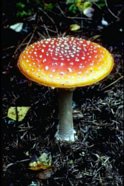 And what about medium-format cameras ? These use 120 rollfilm, which is expensive
and clumsy, but extremely sharp for big enlargements (over 20x30cm).
They also often lack eye-level viewfinders, and I was surprised how much
it helps composition to be
presented with a reversed image on a ground-glass screen.
When you look through a viewfinder, you see the screen with your usual
mental filters on, and ignore many distractions and foreground items -
you still treat the scene as 3-dimensional. But with the ground-glass screen
you are forced to consider the scene as a 2-dimensional projection, just like the
final product, and undesirable elements in the composition become obvious.
Heavy medium format cameras also encourage use of a tripod, which improves discipline.
I unintentionally acquired a Hasselblad 500ELM system, but weighing 4kg with lenses,
and $1000 value, I don't travel with it much.
And what about medium-format cameras ? These use 120 rollfilm, which is expensive
and clumsy, but extremely sharp for big enlargements (over 20x30cm).
They also often lack eye-level viewfinders, and I was surprised how much
it helps composition to be
presented with a reversed image on a ground-glass screen.
When you look through a viewfinder, you see the screen with your usual
mental filters on, and ignore many distractions and foreground items -
you still treat the scene as 3-dimensional. But with the ground-glass screen
you are forced to consider the scene as a 2-dimensional projection, just like the
final product, and undesirable elements in the composition become obvious.
Heavy medium format cameras also encourage use of a tripod, which improves discipline.
I unintentionally acquired a Hasselblad 500ELM system, but weighing 4kg with lenses,
and $1000 value, I don't travel with it much.
 Working with black and white negatives gives total control in the darkroom, and
is cheap, but something is lacking, and that something is colour.
Some subjects look great in B&W - portraits of old men and trains for example,
but B&W is only a subset of colour, so you can always make a monochrome image
on colour media if you want to. Taking colour pictures is just harder,
with more variables to control, and so making the perfect print is difficult,
even if the perfect colour print is likely to be more appealing than the
perfect B&W print.
Many people say "just look what Ansel Adams managed with B&W", and I always
think "so imagine what he could have done if colour film had been perfected earlier".
Working with black and white negatives gives total control in the darkroom, and
is cheap, but something is lacking, and that something is colour.
Some subjects look great in B&W - portraits of old men and trains for example,
but B&W is only a subset of colour, so you can always make a monochrome image
on colour media if you want to. Taking colour pictures is just harder,
with more variables to control, and so making the perfect print is difficult,
even if the perfect colour print is likely to be more appealing than the
perfect B&W print.
Many people say "just look what Ansel Adams managed with B&W", and I always
think "so imagine what he could have done if colour film had been perfected earlier".
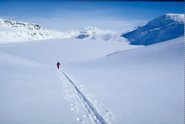 Most advanced photographers take colour slides, since you get the best
colour images that way. You decide exactly how the final image will look at the moment
you press the shutter release, and then you can see the result on a large,
bright screen. Which is great if you know what you are doing (or get lucky),
but half a stop wrong with the exposure can ruin the picture. The snow picture is an
example of getting it right and producing an image that would be disappointing
as a print.
Most advanced photographers take colour slides, since you get the best
colour images that way. You decide exactly how the final image will look at the moment
you press the shutter release, and then you can see the result on a large,
bright screen. Which is great if you know what you are doing (or get lucky),
but half a stop wrong with the exposure can ruin the picture. The snow picture is an
example of getting it right and producing an image that would be disappointing
as a print.
Colour negative film is more exposure tolerant (+/- 2 stops), but you are at the mercy of the processing lab in how your final print looks, and because you will be viewing it by reflected light, it will never look as bright and impressive as a slide. Still, I choose to use print film because I want to make prints for my wall and album, and until recently there was no cheap way to do that well from slides.
The other reason pros use slides is that most publishing houses are geared up exclusively for slides. There are no technological barriers to using negatives for publication, but a lot of inertia and retooling issues.
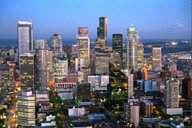 All film types have different contrast and colour-saturation characteristics,
but the differences in print films are often hidden by variations in processing.
I use Kodak Supra 100 for prints,
and Ektachrome 100 for slides (because I have a bunch of free processing vouchers
at home). Many people like the more saturated tones of Fuji velvia.
There are also special films for use under tungsten or fluorescent light,
to avoid having to use heavy filters.
100 ASA used to be the fastest film that could be enlarged to 20x30cm without
grain becoming objectionable, but technology has changed that now.
All film types have different contrast and colour-saturation characteristics,
but the differences in print films are often hidden by variations in processing.
I use Kodak Supra 100 for prints,
and Ektachrome 100 for slides (because I have a bunch of free processing vouchers
at home). Many people like the more saturated tones of Fuji velvia.
There are also special films for use under tungsten or fluorescent light,
to avoid having to use heavy filters.
100 ASA used to be the fastest film that could be enlarged to 20x30cm without
grain becoming objectionable, but technology has changed that now.
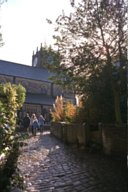 The basic problem in photography is that a typical scene has a contrast
ratio of tens of thousands to one - the brightest highlights are
vastly brighter than the deepest shadows, but photographic media cannot record anything like
as much. Although negative film has a dynamic range of around 1000:1 (10 stops),
printer paper and colour slide film has a range of less than 100:1 (7 stops),
So you need to decide which range from the scene you want to render well - details in the shadows,
but highlights all uniformly white, or details in the highlights and shadow
regions all uniformly black ?
Neither is right or wrong, it's your choice. You must decide what your subject is.
Sometimes you can get two quite different, but equally good, pictures
just by using different exposures.
The basic problem in photography is that a typical scene has a contrast
ratio of tens of thousands to one - the brightest highlights are
vastly brighter than the deepest shadows, but photographic media cannot record anything like
as much. Although negative film has a dynamic range of around 1000:1 (10 stops),
printer paper and colour slide film has a range of less than 100:1 (7 stops),
So you need to decide which range from the scene you want to render well - details in the shadows,
but highlights all uniformly white, or details in the highlights and shadow
regions all uniformly black ?
Neither is right or wrong, it's your choice. You must decide what your subject is.
Sometimes you can get two quite different, but equally good, pictures
just by using different exposures.
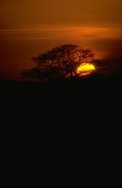 Ironically, it's beautiful sunny days that give the worst problems,
with very bright highlights and deep shadows, and because our eyes can see detail
in both, it's hard to remember that film can't. The church picture and the sunset
are examples of when there is so much contrast that it is impossible to get details in
both highlights and shadows.
Dull, overcast days are much better, even though colours will be subdued. Very
thin cloud is best, as there was for the mushroom picture.
Ironically, it's beautiful sunny days that give the worst problems,
with very bright highlights and deep shadows, and because our eyes can see detail
in both, it's hard to remember that film can't. The church picture and the sunset
are examples of when there is so much contrast that it is impossible to get details in
both highlights and shadows.
Dull, overcast days are much better, even though colours will be subdued. Very
thin cloud is best, as there was for the mushroom picture.
 Much of photographic technique is about reducing contrast, which you can do by
moving into shadow to avoid direct light, or by filling in shadows with a
reflector or flash. The latter is hard to do subtlely, but modern cameras manage
the calculations well.
For Eva on the rock I used a reflector to fill the shadows, and for the railway picture
I took advantage of cloud cover opposite the sun the give a background
that more nearly matched the intensity of the barriers.
Much of photographic technique is about reducing contrast, which you can do by
moving into shadow to avoid direct light, or by filling in shadows with a
reflector or flash. The latter is hard to do subtlely, but modern cameras manage
the calculations well.
For Eva on the rock I used a reflector to fill the shadows, and for the railway picture
I took advantage of cloud cover opposite the sun the give a background
that more nearly matched the intensity of the barriers.
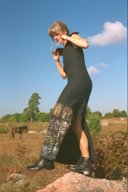 A general rule is that the darkest parts of your image should be just black,
and the lightest parts should be just white - large areas of black or white
generally look ugly. White is worse, so with slides err towards underexposure.
With prints, however, you should err towards overexposure since the print
can easily be underexposed in the darkroom to compensate, but if you
underexpose, the information simply doesn't record on the film, and no
amount of overexposure of the print can get it back. I normally set
my film speed dial to 80ASA to make sure that I always slightly overexpose
my 100ASA print film.
A general rule is that the darkest parts of your image should be just black,
and the lightest parts should be just white - large areas of black or white
generally look ugly. White is worse, so with slides err towards underexposure.
With prints, however, you should err towards overexposure since the print
can easily be underexposed in the darkroom to compensate, but if you
underexpose, the information simply doesn't record on the film, and no
amount of overexposure of the print can get it back. I normally set
my film speed dial to 80ASA to make sure that I always slightly overexpose
my 100ASA print film.
 If film had the same contrast range as the world, we wouldn't need
exposure meters - we would always expose for the same time, and all tones would be
faithfully reproduced. But because we have to choose a subset of the contrast
range to record, we need an exposure meter.
This tells us the average brightness of the area it's pointed at,
and expresses this as the exposure settings that will render it as 18% grey
(or the colour equivalent) on your film (which happens to be perceived
as half way between black and white by our logarithmic eyes).
This is great if you're photographing an 18% grey piece of card, which
will then be faithfully reproduced on the film. But if you are photographing
a snow field with your grey card somewhere in the scene, your meter will
now tell you to expose less, so that now the snow will now record as 18% grey,
and your card will appear very dark. Take your card into a coal cellar,
and your meter will suggest a long exposure that will make the coal look 18%,
but the card will be very pale. But these are extreme cases, if you point your
meter at an average subject, the average density on the film will be 18%,
and for 90% of general photography this works just fine, and I rely on
my automatic metering most of the time.
If film had the same contrast range as the world, we wouldn't need
exposure meters - we would always expose for the same time, and all tones would be
faithfully reproduced. But because we have to choose a subset of the contrast
range to record, we need an exposure meter.
This tells us the average brightness of the area it's pointed at,
and expresses this as the exposure settings that will render it as 18% grey
(or the colour equivalent) on your film (which happens to be perceived
as half way between black and white by our logarithmic eyes).
This is great if you're photographing an 18% grey piece of card, which
will then be faithfully reproduced on the film. But if you are photographing
a snow field with your grey card somewhere in the scene, your meter will
now tell you to expose less, so that now the snow will now record as 18% grey,
and your card will appear very dark. Take your card into a coal cellar,
and your meter will suggest a long exposure that will make the coal look 18%,
but the card will be very pale. But these are extreme cases, if you point your
meter at an average subject, the average density on the film will be 18%,
and for 90% of general photography this works just fine, and I rely on
my automatic metering most of the time.
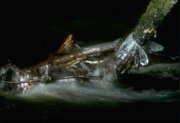 Sometimes you don't want this general reading though. The icy stream has a lot
of shadows in it, and a general meter reading would have resulted in these
being too light, so I moved in and took the reading from only the branch and water.
Some cameras have a spot-metering option where only the central portion
of the screen is used for the reading, and advanced modern cameras do
image processing to try and identify the subject themselves. It amazes
me that they often get it right.
Sometimes you don't want this general reading though. The icy stream has a lot
of shadows in it, and a general meter reading would have resulted in these
being too light, so I moved in and took the reading from only the branch and water.
Some cameras have a spot-metering option where only the central portion
of the screen is used for the reading, and advanced modern cameras do
image processing to try and identify the subject themselves. It amazes
me that they often get it right.
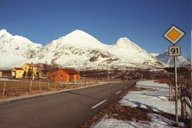 Flash - not just for indoors, but for shadow fill-in outdoors. It's almost
worth buying a modern camera for this feature alone, which would save
dozens of contrasty summer portraits from the bin.
Flash - not just for indoors, but for shadow fill-in outdoors. It's almost
worth buying a modern camera for this feature alone, which would save
dozens of contrasty summer portraits from the bin.
Filters - I always have an ultraviolet ("skylight") filter on my lenses,
partly to avoid the blue haze from UV scatter in the atmosphere,
but also to protect them from scratches and fingerprints.
A polarizer darkens blue skies to make them record more like they appear to
the eye (another case of contrast reduction), and their effect is
strongest at around 100° from the sun. But be careful - on clear days at
altitude the effect can be too strong, and the sky will go black.
All the other filters are really for special effects, and I rarely use them.
Some people think that using filters is 'cheating' in that they distort reality,
but they are more often used to correct for limitations in the recording system
in order to produce a better representation of reality (or perception).
Choice of viewpoint and exposure are much more common culprits for distorting reality.
And there is no magic filter for 'good colours', but you still hear people
dismissing great photographs with "Oh, he just uses filters".
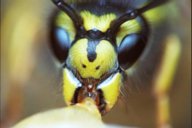 Close-up equipment - Supplementary lenses are cheap but usually degrade quality,
extension tubes give the best quality, but reduce the effective speed of
your lens. Personally I tape another lens back-to-front on my main lens
(which is in effect an expensive supplementary lens). I can get better
than 5:1 magnification with this setup.
Close-up equipment - Supplementary lenses are cheap but usually degrade quality,
extension tubes give the best quality, but reduce the effective speed of
your lens. Personally I tape another lens back-to-front on my main lens
(which is in effect an expensive supplementary lens). I can get better
than 5:1 magnification with this setup.
 Digital update 2005 :
Digital update 2005 :
In the last 4 years a lot has happened to digital cameras. In particular
serious SLRs have become affordable. First under $1000 came the Canon 300D,
which is a great camera, but a few months later the Nikon D70 leapfrogged
into pole position as the serious amateur's first digital camera. Go see the
Nikonians D70 forum to find out why.
The Olympus E300 (called the eVolt in the USA) is also a worthy contender.
I was finally pursuaded to go digital after I borrowed a Canon 300D from work
over Christmas and two of the pictures I took in that week got published nationally.
So I bought a Nikon D70, and have upped my success rate simply by being willing to
take more shots (of course shooting an extra $1000 worth of film would have
a similar effect, but is harder to justify on a daily basis). Instant feedback
has also helps with technically difficult shots like the candle, which I would
never have attempted with film. I took at least 10 shots, adjusting the
balance between ambient light, flash, and the candle flame after looking
at each image on the LCD screen.
The final result got published in the Christmas edition of a climbing magazine.
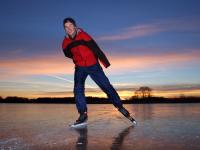 Capturing Marian skating was
made much easier by having motordrive, automatic built-in fill flash, autofocus,
and instant feedback on whether I had caught the image I wanted. I would have
needed more luck (and film) to get the shot with the old Olympus.
Going digital has also injected me with a new enthusiasm for photography, and
made it fun again - now I take pictures of things that I would never have spent film on,
things like the November cactus, for which I had no hopes for success,
but which was a fun challenge to capture, and gave a surprisingly pleasing result.
Capturing Marian skating was
made much easier by having motordrive, automatic built-in fill flash, autofocus,
and instant feedback on whether I had caught the image I wanted. I would have
needed more luck (and film) to get the shot with the old Olympus.
Going digital has also injected me with a new enthusiasm for photography, and
made it fun again - now I take pictures of things that I would never have spent film on,
things like the November cactus, for which I had no hopes for success,
but which was a fun challenge to capture, and gave a surprisingly pleasing result.
For prints up to 20x30cm, 6 megapixels is plenty, and I can't distinguish
the tonal qualities from those of film when I get the exposure right.
But if I underexpose I get colour noise in the shadows, and if I overexpose
the highlights blow in a more unpleasant way than film - the response curve of
the sensor is such that highlights cut off harder, and the component colours
do so at slightly different points, so colour fringing is more likely.
The latitude is also less than print film, and more like slide.
The other downsides are the size and cost, which as I mentioned earlier, mean
leaving it at home more often than my old Olympus. And on a long backcountry
trip, power and image storage become an issue.
Plus I miss the simplicity of film.
So it's still not an obvious choice
to shelve your film camera, but as of 2005 it's at least a reasonable choice.
Digital update 2008 :
Well, I think it's fair to say that film is dead except for a few professionals
and artsy amateurs. 10 MP cameras are available for a few hundred dollars
and for $1000 you get a semi-pro camera that gives better results that the best
35mm film cameras ever did.
I still miss the size and simplicity of my film system, but the quantity and quality of
my keepers is many times greater with digital (currently with a Nikon D300).
There are a million new issues to think about, especially in postprocessing
of the files, but there is so much information on the web now that I won't
get started on that myself. Here's a good place to start : The Luminous Landscape.
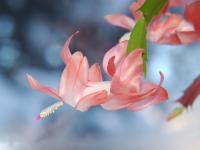 Having spent 4 pages on the technical introduction, I shall now dismiss the
actual photographic event in a couple of paragraphs. Why ? Because I think that
it's very difficult to teach someone the art of taking good pictures.
You can teach them the equipment so that they don't lose pictures to technical errors,
but I believe that you either have an eye for an image or you don't, and
the only way to develop that eye is to get out taking pictures, and then
critically assess your results, trying to identify what it is about the good shots
that appeals to you. Ask your friends too, as everyone's taste is different,
but there is a core æsthetic that gives the terms 'good picture' and
'bad picture' meaning. If you can't recognise that natural æsthetic
then you are probably doomed to the fringe, but if you still like your pictures
there's nothing wrong with that. All's fair in art and Scandinavia.
Having spent 4 pages on the technical introduction, I shall now dismiss the
actual photographic event in a couple of paragraphs. Why ? Because I think that
it's very difficult to teach someone the art of taking good pictures.
You can teach them the equipment so that they don't lose pictures to technical errors,
but I believe that you either have an eye for an image or you don't, and
the only way to develop that eye is to get out taking pictures, and then
critically assess your results, trying to identify what it is about the good shots
that appeals to you. Ask your friends too, as everyone's taste is different,
but there is a core æsthetic that gives the terms 'good picture' and
'bad picture' meaning. If you can't recognise that natural æsthetic
then you are probably doomed to the fringe, but if you still like your pictures
there's nothing wrong with that. All's fair in art and Scandinavia.
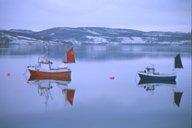 Burn film. 80% of my landscapes end up in the bin, 20% get into albums, and
about 2% get on to my walls. Portraits give me about half that number of keepers,
and professionals have even higher attrition rates. And why do we take all those
bad pictures ? Well, most are not bad but dull, the scenery just doesn't look
as exciting when divorced from the emotions of being there. And then there is the mental
filtering that we do as we look at a scene, conveniently blanking out distracting
foreground elements that look terrible when projected into the final 2-D image.
So try to be objective as you look into the viewfinder, and remember that it is a
2-D projection that you are looking at, not a window on the impressive 3-D world
in front of you.
Burn film. 80% of my landscapes end up in the bin, 20% get into albums, and
about 2% get on to my walls. Portraits give me about half that number of keepers,
and professionals have even higher attrition rates. And why do we take all those
bad pictures ? Well, most are not bad but dull, the scenery just doesn't look
as exciting when divorced from the emotions of being there. And then there is the mental
filtering that we do as we look at a scene, conveniently blanking out distracting
foreground elements that look terrible when projected into the final 2-D image.
So try to be objective as you look into the viewfinder, and remember that it is a
2-D projection that you are looking at, not a window on the impressive 3-D world
in front of you.
Soon after writing this, I discovered that Phil Greenspun's extraordinary site covers everything I have said, but devotes an entire chapter to subjects I've dismissed in one sentence. Go see him at photo.net